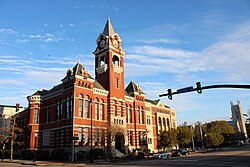
New Hanover County Courthouse is a historic courthouse building located in Wilmington, North Carolina and is the seat of New Hanover County. [1] It was designed by Alfred Eichberg and James F. Post. [2] [3] The courthouse was erected in 1892 at corner of 3rd Street and Princess Street. An annex was built in 1925. [4]
